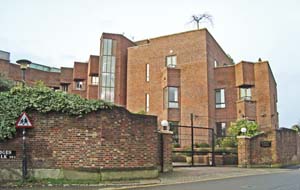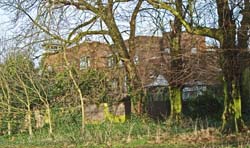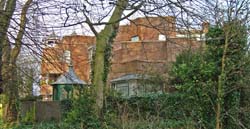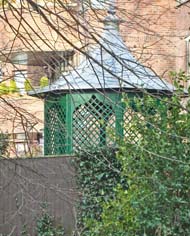Clara
Baroness de Hirsch Convalescent Home
Tudor
House, The Grove, Hampstead Heath,
NW3 6RF
Medical
dates:
Medical
character:
Convalescent
In January 1898 Baroness
de Hirsch (1833-1899), a philanthropist living in Paris, purchased Tudor House, a large
freehold property on Hampstead Heath, for
£16,000 in order to establish a convalescent home for
Anglo-Jewish patients.
The Clara Baroness de Hirsch Convalescent Home was officially opened in December 1898 by Lady Lewis. The ceremony had been hastened for fear that the Baroness, President of the Home, who had been in ailing health for many years, might not live to see the day. The Home was consecrated by the Chief Rabbi, who paid tribute to the unlimited generosity of the Baroness, who had fully endowed the Home, and to the unselfish and able work done by Mrs H.L. Bischoffsheim.
The Baroness died in Paris on 1st April 1899 at the age of 65 years. Mrs Bischoffsheim, who had been Vice-President, became the President of the Home.
The 7-bedroomed red brick mansion had been built in mock Tudor style. Initially, it had 6 beds - 3 for men and 3 for women. There were 5 rooms for resident nursing and domestic staff. As well as a breakfast room, a dining room (and a 'noble' Tudor dining room, a double drawing room and a Japanese morning room, there were a library, a Tower room and a tessellated verandah. The house was set in ornamental grounds with a tennis lawn and a rockery with a rustic bridge.
Later a children's ward was added to the Home in memory of the Baroness, paid for by her uncle Henri (Henry) Bischoffsheim.
During 1907 some 30 patients were received at the Home, 19 of whom had been referred from the London Hospital.
During WW1 the Home closed in October 1917 due to rising prices and higher running costs.
However, it reopened again in the summer of 1918 under the care of the British Red Cross. It became the Tudor House Military Hospital for Jewish soldiers and had 50 beds. All expenses were defrayed by Mrs Bischoffsheim.
In June 1920 the Home reopened as a convalescent home for men, women and children. It had 30 beds.
During 1921 some 572 patients were admitted.
At the beginning of 1922 the children's ward closed and the children were moved to the men's ward. Only 313 patients were admitted during that year.
The children's ward was still closed in January 1923 but, in the spring, the First Women's Lodge of England (London 56) of the Independent Order of B'nai Brith funded 4 beds for children for a period of six months, at a cost not exceeding 25 shillings (£1.25) a week per bed. After Passover, additional beds were set up and, later, more beds, so that funding by B'nai Brith enabled the whole children's ward to reopen.
Poor patients were admitted free of charge, but an experimental arrangement established with the Order "Achei Brith" and "Shield of Abraham" enabled a small number of female members to receive treatment at the Home.
By the end of 1923 some 440 patients had been admitted to the Home, of whom 213 had come on their own application following a private recommendation. Most of the remainder had been referred from the London Hospital, the London Jewish Hospital, the German Hospital and the Metropolitan Hospital; 75 patients came from other hospitals and infirmaries. Their average stay was three weeks. The average cost of an in-patient was £1 16s 7d (£1.83) a week.
The Home closed in 1926.
Present status (February 2010)
The Clara Baroness de Hirsch Convalescent Home was officially opened in December 1898 by Lady Lewis. The ceremony had been hastened for fear that the Baroness, President of the Home, who had been in ailing health for many years, might not live to see the day. The Home was consecrated by the Chief Rabbi, who paid tribute to the unlimited generosity of the Baroness, who had fully endowed the Home, and to the unselfish and able work done by Mrs H.L. Bischoffsheim.
The Baroness died in Paris on 1st April 1899 at the age of 65 years. Mrs Bischoffsheim, who had been Vice-President, became the President of the Home.
The 7-bedroomed red brick mansion had been built in mock Tudor style. Initially, it had 6 beds - 3 for men and 3 for women. There were 5 rooms for resident nursing and domestic staff. As well as a breakfast room, a dining room (and a 'noble' Tudor dining room, a double drawing room and a Japanese morning room, there were a library, a Tower room and a tessellated verandah. The house was set in ornamental grounds with a tennis lawn and a rockery with a rustic bridge.
Later a children's ward was added to the Home in memory of the Baroness, paid for by her uncle Henri (Henry) Bischoffsheim.
During 1907 some 30 patients were received at the Home, 19 of whom had been referred from the London Hospital.
During WW1 the Home closed in October 1917 due to rising prices and higher running costs.
However, it reopened again in the summer of 1918 under the care of the British Red Cross. It became the Tudor House Military Hospital for Jewish soldiers and had 50 beds. All expenses were defrayed by Mrs Bischoffsheim.
In June 1920 the Home reopened as a convalescent home for men, women and children. It had 30 beds.
During 1921 some 572 patients were admitted.
At the beginning of 1922 the children's ward closed and the children were moved to the men's ward. Only 313 patients were admitted during that year.
The children's ward was still closed in January 1923 but, in the spring, the First Women's Lodge of England (London 56) of the Independent Order of B'nai Brith funded 4 beds for children for a period of six months, at a cost not exceeding 25 shillings (£1.25) a week per bed. After Passover, additional beds were set up and, later, more beds, so that funding by B'nai Brith enabled the whole children's ward to reopen.
Poor patients were admitted free of charge, but an experimental arrangement established with the Order "Achei Brith" and "Shield of Abraham" enabled a small number of female members to receive treatment at the Home.
By the end of 1923 some 440 patients had been admitted to the Home, of whom 213 had come on their own application following a private recommendation. Most of the remainder had been referred from the London Hospital, the London Jewish Hospital, the German Hospital and the Metropolitan Hospital; 75 patients came from other hospitals and infirmaries. Their average stay was three weeks. The average cost of an in-patient was £1 16s 7d (£1.83) a week.
The Home closed in 1926.
Present status (February 2010)
In 1935 Viscount and Viscountess Astor, who had bought the property, presented it to the newly formed Hawthorne Trust to use as a Christian Science nursing home.
Tudor House was renamed Hawthorne House. It opened in 1937, the first Christian Science House in the United Kingdom.
In 1948 the Hawthorne Christian Science House was disclaimed from the NHS.
It was sold in November 1987, when the Trust relocated the Home to Charton Manor.
The building was demolished and Summit Lodge, an apartment block, now occupies its site.

Summit Lodge, at the top of Hampstead Heath, reputedly contains the highest room to be found in London.

The building is well screened by the trees on Hampstead Heath (above and below).


Perhaps an old garden shelter left over from the former convalescent home.
(Author unstated) 1898 Reflections from a Board Room Mirror. Nursing Record and Hospital World, 24th December, 516.
(Author unstated) 1908 Hospital and dispensary management. Convalescent Homes Association. British Medical Journal 1 (2475), 1402.
(Author unstated) 2011 Not for sale. Camden Local Studies and Archives Centre Newsletter 24, 20th July.
Maxwell A 1912 Hampstead: Its Historic Houses - Its Literary and Artistic Associations. London, James Clarke & Co., p.20.
www.movinghere.org (1)
www.movinghere.org (2)
www.movinghere.org (3)
www.movinghere.org (4)
www.rgcrompton.info
www.southampton.ac.uk
Return to home page